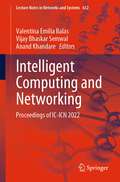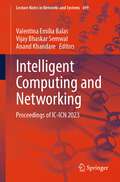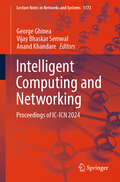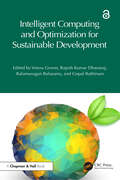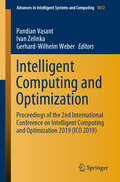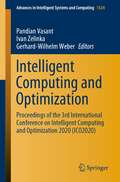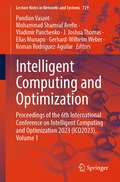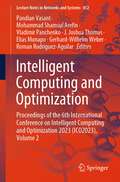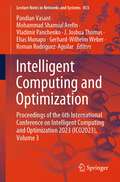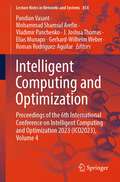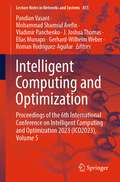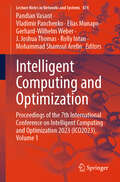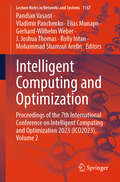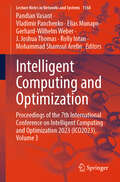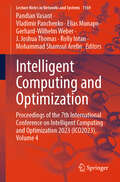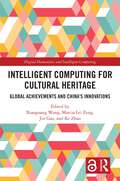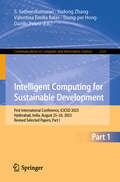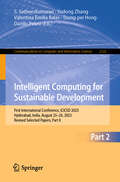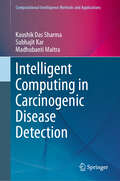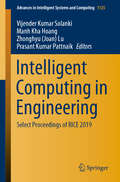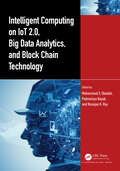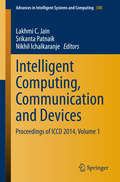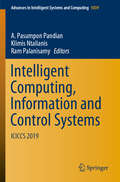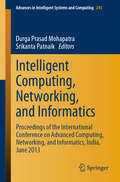- Table View
- List View
Intelligent Computing and Networking: Proceedings of IC-ICN 2022 (Lecture Notes in Networks and Systems #632)
by Valentina Emilia Balas Vijay Bhaskar Semwal Anand KhandareThis book gathers high-quality peer-reviewed research papers presented at the International Conference on Intelligent Computing and Networking (IC-ICN 2022), organized by the Computer Department, Thakur College of Engineering and Technology, in Mumbai, Maharashtra, India, on February 25–26, 2022. The book includes innovative and novel papers in the areas of intelligent computing, artificial intelligence, machine learning, deep learning, fuzzy logic, natural language processing, human–machine interaction, big data mining, data science and mining, applications of intelligent systems in healthcare, finance, agriculture and manufacturing, high-performance computing, computer networking, sensor and wireless networks, Internet of Things (IoT), software-defined networks, cryptography, mobile computing, digital forensics and blockchain technology.
Intelligent Computing and Networking: Proceedings of IC-ICN 2023 (Lecture Notes in Networks and Systems #699)
by Valentina Emilia Balas Vijay Bhaskar Semwal Anand KhandareThis book gathers high-quality peer-reviewed research papers presented at the International Conference on Intelligent Computing and Networking (IC-ICN 2023), organized by the Computer Engineering Department, Thakur College of Engineering and Technology, in Mumbai, Maharashtra, India, on February 24–25, 2023. The book includes innovative and novel papers in the areas of intelligent computing, artificial intelligence, machine learning, deep learning, fuzzy logic, natural language processing, human–machine interaction, big data mining, data science and mining, applications of intelligent systems in healthcare, finance, agriculture and manufacturing, high-performance computing, computer networking, sensor and wireless networks, Internet of Things (IoT), software-defined networks, cryptography, mobile computing, digital forensics and blockchain technology.
Intelligent Computing and Networking: Proceedings of IC-ICN 2024 (Lecture Notes in Networks and Systems #1172)
by George Ghinea Vijay Bhaskar Semwal Anand KhandareThis book gathers high-quality peer-reviewed research papers presented at the International Conference on Intelligent Computing and Networking (IC-ICN 2024), organized by the Computer Department, Thakur College of Engineering and Technology, in Mumbai, Maharashtra, India, on February 23–24, 2024. The book includes innovative and novel papers in the areas of intelligent computing, artificial intelligence, machine learning, deep learning, fuzzy logic, natural language processing, human–machine interaction, big data mining, data science and mining, applications of intelligent systems in healthcare, finance, agriculture and manufacturing, high-performance computing, computer networking, sensor and wireless networks, Internet of Things (IoT), software-defined networks, cryptography, mobile computing, digital forensics, and blockchain technology.
Intelligent Computing and Optimization for Sustainable Development
by Balamurugan Balusamy Rajesh Kumar Dhanaraj Veena Grover Gopal RathinamThis book presents insights into how Intelligent Computing and Optimization techniques can be used to attain the goals of Sustainable Development. It provides a comprehensive overview of the latest breakthroughs and recent developments in sustainable, intelligent computing technologies, applications, and optimization techniques across various industries, including business process management, manufacturing, financial sector, agriculture, financial sector, supply chain management, and healthcare. It focuses on computational intelligent techniques and optimization techniques to provide sustainable solutions to many problems. Features: Provides insights into the theory, implementation, and application of computational intelligence techniques in many industries Includes industry practitioner perspectives and case studies for a better understanding of sustainable solutions Highlights the role of intelligent computing and optimization as key technologies in decision-making processes and in providing cutting-edge solutions to real-world problems Addresses the challenges and limitations of computational approaches in sustainability, such as data availability, model uncertainty, and computational complexity, while also discusses emerging opportunities and future directions in the field This book will be useful for professionals and scholars looking for up-to-date research on cutting-edge perspectives in the field of computational intelligent and optimization techniques in the areas of agriculture, industry, financial sector, business automation, renewable energy, optimization, and smart cities.
Intelligent Computing and Optimization: Proceedings of the 2nd International Conference on Intelligent Computing and Optimization 2019 (ICO 2019) (Advances in Intelligent Systems and Computing #1072)
by Pandian Vasant Ivan Zelinka Gerhard-Wilhelm WeberThis book presents the outcomes of the second edition of the International Conference on Intelligent Computing and Optimization (ICO) – ICO 2019, which took place on October 3–4, 2019, in Koh Samui, Thailand. Bringing together research scholars, experts, and investigators from around the globe, the conference provided a platform to share novel research findings, recent advances and innovative applications in the field. Discussing the need for smart disciplinary processes embedded into interdisciplinary collaborations in the context of meeting the growing global populations’ requirements, such as food and health care, the book highlights the role of intelligent computation and optimization as key technologies in decision-making processes and in providing cutting edge solutions to real-world problems.
Intelligent Computing and Optimization: Proceedings of the 3rd International Conference on Intelligent Computing and Optimization 2020 (ICO 2020) (Advances in Intelligent Systems and Computing #1324)
by Pandian Vasant Ivan Zelinka Gerhard-Wilhelm WeberThird edition of International Conference on Intelligent Computing and Optimization and as a premium fruit, this book, pursue to gather research leaders, experts and scientists on Intelligent Computing and Optimization to share knowledge, experience and current research achievements. Conference and book provide a unique opportunity for the global community to interact and share novel research results, explorations and innovations among colleagues and friends. This book is published by SPRINGER, Advances in Intelligent Systems and Computing. Ca. 100 authors submitted full papers to ICO’2020. That global representation demonstrates the growing interest of the research community here. The book covers innovative and creative research on sustainability, smart cities, meta-heuristics optimization, cyber-security, block chain, big data analytics, IoTs, renewable energy, artificial intelligence, Industry 4.0, modeling and simulation. We editors thank all authors and reviewers for their important service. Best high-quality papers have been selected by the International PC for our premium series with SPRINGER.
Intelligent Computing and Optimization: Proceedings of the 6th International Conference on Intelligent Computing and Optimization 2023 (ICO2023), Volume 1 (Lecture Notes in Networks and Systems #729)
by Pandian Vasant Gerhard-Wilhelm Weber Roman Rodriguez-Aguilar Mohammad Shamsul Arefin Elias Munapo J. Joshua Thomas Vladimir PanchenkoThis book of Springer Nature is another proof of Springer’s outstanding greatness on the lively interface of Holistic Computational Optimization, Green IoTs, Smart Modeling, and Deep Learning! It is a masterpiece of what our community of academics and experts can provide when an interconnected approach of joint, mutual, and meta-learning is supported by advanced operational research and experience of the World-Leader Springer Nature! The 6th edition of International Conference on Intelligent Computing and Optimization took place at G Hua Hin Resort & Mall on April 27–28, 2023, with tremendous support from the global research scholars across the planet. Objective is to celebrate “Research Novelty with Compassion and Wisdom” with researchers, scholars, experts, and investigators in Intelligent Computing and Optimization across the globe, to share knowledge, experience, and innovation—a marvelous opportunity for discourse and mutuality by novel research, invention, and creativity. This proceedings book of the 6th ICO’2023 is published by Springer Nature—Quality Label of Enlightenment.
Intelligent Computing and Optimization: Proceedings of the 6th International Conference on Intelligent Computing and Optimization 2023 (ICO2023), Volume 2 (Lecture Notes in Networks and Systems #852)
by Pandian Vasant Gerhard-Wilhelm Weber Roman Rodriguez-Aguilar Mohammad Shamsul Arefin Elias Munapo J. Joshua Thomas Vladimir PanchenkoThis book of Springer Nature is another proof of Springer’s outstanding greatness on the lively interface of Holistic Computational Optimization, Green IoTs, Smart Modeling, and Deep Learning! It is a masterpiece of what our community of academics and experts can provide when an interconnected approach of joint, mutual, and meta-learning is supported by advanced operational research and experience of the World-Leader Springer Nature! The 6th edition of International Conference on Intelligent Computing and Optimization took place at G Hua Hin Resort & Mall on April 27–28, 2023, with tremendous support from the global research scholars across the planet. Objective is to celebrate “Research Novelty with Compassion and Wisdom” with researchers, scholars, experts, and investigators in Intelligent Computing and Optimization across the globe, to share knowledge, experience, and innovation—a marvelous opportunity for discourse and mutuality by novel research, invention, and creativity. This proceedings book of the 6th ICO’2023 is published by Springer Nature—Quality Label of Enlightenment.
Intelligent Computing and Optimization: Proceedings of the 6th International Conference on Intelligent Computing and Optimization 2023 (ICO2023), Volume 3 (Lecture Notes in Networks and Systems #853)
by Pandian Vasant Gerhard-Wilhelm Weber Roman Rodriguez-Aguilar Mohammad Shamsul Arefin Elias Munapo J. Joshua Thomas Vladimir PanchenkoThis book of Springer Nature is another proof of Springer’s outstanding greatness on the lively interface of Holistic Computational Optimization, Green IoTs, Smart Modeling, and Deep Learning! It is a masterpiece of what our community of academics and experts can provide when an interconnected approach of joint, mutual, and meta-learning is supported by advanced operational research and experience of the World-Leader Springer Nature! The 6th edition of International Conference on Intelligent Computing and Optimization took place at G Hua Hin Resort & Mall on April 27–28, 2023, with tremendous support from the global research scholars across the planet. Objective is to celebrate “Research Novelty with Compassion and Wisdom” with researchers, scholars, experts, and investigators in Intelligent Computing and Optimization across the globe, to share knowledge, experience, and innovation—a marvelous opportunity for discourse and mutuality by novel research, invention, and creativity. This proceedings book of the 6th ICO’2023 is published by Springer Nature—Quality Label of Enlightenment.
Intelligent Computing and Optimization: Proceedings of the 6th International Conference on Intelligent Computing and Optimization 2023 (ICO2023), Volume 4 (Lecture Notes in Networks and Systems #854)
by Pandian Vasant Gerhard-Wilhelm Weber Roman Rodriguez-Aguilar Mohammad Shamsul Arefin Elias Munapo J. Joshua Thomas Vladimir PanchenkoThis book of Springer Nature is another proof of Springer’s outstanding greatness on the lively interface of Holistic Computational Optimization, Green IoTs, Smart Modeling, and Deep Learning! It is a masterpiece of what our community of academics and experts can provide when an interconnected approach of joint, mutual, and meta-learning is supported by advanced operational research and experience of the World-Leader Springer Nature! The 6th edition of International Conference on Intelligent Computing and Optimization took place at G Hua Hin Resort & Mall on April 27–28, 2023, with tremendous support from the global research scholars across the planet. Objective is to celebrate “Research Novelty with Compassion and Wisdom” with researchers, scholars, experts, and investigators in Intelligent Computing and Optimization across the globe, to share knowledge, experience, and innovation—a marvelous opportunity for discourse and mutuality by novel research, invention, and creativity. This proceedings book of the 6th ICO’2023 is published by Springer Nature—Quality Label of Enlightenment.
Intelligent Computing and Optimization: Proceedings of the 6th International Conference on Intelligent Computing and Optimization 2023 (ICO2023), Volume 5 (Lecture Notes in Networks and Systems #855)
by Pandian Vasant Gerhard-Wilhelm Weber Roman Rodriguez-Aguilar Mohammad Shamsul Arefin Elias Munapo J. Joshua Thomas Vladimir PanchenkoThis book of Springer Nature is another proof of Springer’s outstanding greatness on the lively interface of Holistic Computational Optimization, Green IoTs, Smart Modeling, and Deep Learning! It is a masterpiece of what our community of academics and experts can provide when an interconnected approach of joint, mutual, and meta-learning is supported by advanced operational research and experience of the World-Leader Springer Nature! The 6th edition of International Conference on Intelligent Computing and Optimization took place at G Hua Hin Resort & Mall on April 27–28, 2023, with tremendous support from the global research scholars across the planet. Objective is to celebrate “Research Novelty with Compassion and Wisdom” with researchers, scholars, experts, and investigators in Intelligent Computing and Optimization across the globe, to share knowledge, experience, and innovation—a marvelous opportunity for discourse and mutuality by novel research, invention, and creativity. This proceedings book of the 6th ICO’2023 is published by Springer Nature—Quality Label of Enlightenment.
Intelligent Computing and Optimization: Proceedings of the 7th International Conference on Intelligent Computing and Optimization 2023 (ICO2023), Volume 1 (Lecture Notes in Networks and Systems #874)
by Pandian Vasant Gerhard-Wilhelm Weber Rolly Intan Mohammad Shamsul Arefin Elias Munapo J. Joshua Thomas Vladimir PanchenkoThis book of Springer Nature is another proof of Springer’s outstanding and greatness on the lively interface of Smart Computational Optimization, Green Infrastructure, Innovative Modeling and Deep Learning Architectures! It is a Master Piece of what our community of Academics and Experts can provide when an Interconnected Approach of Joint, Mutual and Meta Learning is supported by Holistic Operational Research and Experience of the World-Leader Springer Nature! The 7th edition of International Conference on Intelligent Computing and Optimization took place at Baitong Hotel & Resort on October 26–27, 2023, with tremendous support from the global research scholars across the planet. Objective was to celebrate “Global Research Quality with Compassion and Wisdom” with researchers, scholars, experts and investigators in Intelligent Computing and Optimization across the globe,to share knowledge, experience and innovation—a marvelous opportunity for discourse and mutuality by novel research, invention and creativity. This proceedings book of the 7th ICO’2023 is published by Springer Nature—Creativity Label of Inspiration.
Intelligent Computing and Optimization: Proceedings of the 7th International Conference on Intelligent Computing and Optimization 2023 (ICO2023), Volume 2 (Lecture Notes in Networks and Systems #1167)
by Pandian Vasant Gerhard-Wilhelm Weber Rolly Intan Mohammad Shamsul Arefin Elias Munapo J. Joshua Thomas Vladimir PanchenkoThis book of Springer Nature is another proof of Springer’s outstanding and greatness on the lively interface of Smart Computational Optimization, Green Infrastructure, Innovative Modeling and Deep Learning Architectures! It is a Master Piece of what our community of Academics and Experts can provide when an Interconnected Approach of Joint, Mutual and Meta Learning is supported by Holistic Operational Research and Experience of the World-Leader Springer Nature! The 7th edition of International Conference on Intelligent Computing and Optimization took place at Baitong Hotel & Resort on October 26–27, 2023, with tremendous support from the global research scholars across the planet. Objective was to celebrate “Global Research Quality with Compassion and Wisdom” with researchers, scholars, experts and investigators in Intelligent Computing and Optimization across the globe,to share knowledge, experience and innovation—a marvelous opportunity for discourse and mutuality by novel research, invention and creativity. This proceedings book of the 7th ICO’2023 is published by Springer Nature—Creativity Label of Inspiration.
Intelligent Computing and Optimization: Proceedings of the 7th International Conference on Intelligent Computing and Optimization 2023 (ICO2023), Volume 3 (Lecture Notes in Networks and Systems #1168)
by Pandian Vasant Gerhard-Wilhelm Weber Rolly Intan Mohammad Shamsul Arefin Elias Munapo J. Joshua Thomas Vladimir PanchenkoThis book of Springer Nature is another proof of Springer’s outstanding and greatness on the lively interface of Smart Computational Optimization, Green Infrastructure, Innovative Modeling and Deep Learning Architectures! It is a Master Piece of what our community of Academics and Experts can provide when an Interconnected Approach of Joint, Mutual and Meta Learning is supported by Holistic Operational Research and Experience of the World-Leader Springer Nature! The 7th edition of International Conference on Intelligent Computing and Optimization took place at Baitong Hotel & Resort on October 26–27, 2023, with tremendous support from the global research scholars across the planet. Objective was to celebrate “Global Research Quality with Compassion and Wisdom” with researchers, scholars, experts and investigators in Intelligent Computing and Optimization across the globe,to share knowledge, experience and innovation—a marvelous opportunity for discourse and mutuality by novel research, invention and creativity. This proceedings book of the 7th ICO’2023 is published by Springer Nature—Creativity Label of Inspiration.
Intelligent Computing and Optimization: Proceedings of the 7th International Conference on Intelligent Computing and Optimization 2023 (ICO2023), Volume 4 (Lecture Notes in Networks and Systems #1169)
by Pandian Vasant Gerhard-Wilhelm Weber Rolly Intan Mohammad Shamsul Arefin Elias Munapo J. Joshua Thomas Vladimir PanchenkoThis book of Springer Nature is another proof of Springer’s outstanding and greatness on the lively interface of Smart Computational Optimization, Green Infrastructure, Innovative Modeling and Deep Learning Architectures! It is a Master Piece of what our community of Academics and Experts can provide when an Interconnected Approach of Joint, Mutual and Meta Learning is supported by Holistic Operational Research and Experience of the World-Leader Springer Nature! The 7th edition of International Conference on Intelligent Computing and Optimization took place at Baitong Hotel & Resort on October 26–27, 2023, with tremendous support from the global research scholars across the planet. Objective was to celebrate “Global Research Quality with Compassion and Wisdom” with researchers, scholars, experts and investigators in Intelligent Computing and Optimization across the globe,to share knowledge, experience and innovation—a marvelous opportunity for discourse and mutuality by novel research, invention and creativity. This proceedings book of the 7th ICO’2023 is published by Springer Nature—Creativity Label of Inspiration.
Intelligent Computing for Cultural Heritage: Global Achievements and China's Innovations (Digital Humanities and Intelligent Computing)
by Marcia Lei Zeng Xiaoguang Wang Jin Gao Ke ZhaoThis book offers a global perspective on the latest advancements and trends in digital humanities and intelligent computing of cultural heritage, covering both academic research and case studies within cultural institutions.This edited volume brings together views and practices from different regions, including Asia, Europe, Africa, North America, and Australia. It offers innovative approaches and case studies related to humanities data and digital methods, with a focus on digital humanities research and pedagogy and cultural heritage organisation and preservation, in particular the development of digital knowledge repositories and methods for digital intelligence in cultural heritage. Each case study highlights unique cultural characteristics and academic histories, resulting in diverse development priorities and thematic directions. However, this diversity can also lead to imbalances and isolation within the field. To gain a better understanding of the complex trends in the development of the digital humanities, this book offers valuable insights from case studies and research practices, showcasing global contributions from scholars and institutions.This title will appeal to scholars and students of digital humanities and information science, particularly those studying heritage management and intelligent computing. Professionals working at the intersection of technology and cultural heritage will also find this book of great interest.The Open Access version of this book, available at http://www.taylorfrancis.com, has been made available under a Creative Commons Attribution-Non Commercial-No Derivatives (CC-BY-NC-ND) 4.0 license.
Intelligent Computing for Sustainable Development: First International Conference, ICICSD 2023, Hyderabad, India, August 25–26, 2023, Revised Selected Papers, Part I (Communications in Computer and Information Science #2121)
by Tzung-Pei Hong Valentina Emilia Balas Danilo Pelusi Yudong Zhang S. SatheeskumaranThe two-volume proceedings set CCIS 2121 and 2122 constitutes the refereed proceedings of the First International Conference on Intelligent Computing for Sustainable Development, ICICSD 2023, which took place in Hyderabad, India, during August 25–26, 2023. The 46 papers included in these proceedings were carefully reviewed and selected from 138 submissions. They focus on digital healthcare, renewable energy, smart cities, digital farming, and autonomous systems.
Intelligent Computing for Sustainable Development: First International Conference, ICICSD 2023, Hyderabad, India, August 25–26, 2023, Revised Selected Papers, Part II (Communications in Computer and Information Science #2122)
by Tzung-Pei Hong Valentina Emilia Balas Danilo Pelusi Yudong Zhang S. SatheeskumaranThe two-volume proceedings set CCIS 2121 and 2122 constitutes the refereed proceedings of the First International Conference on Intelligent Computing for Sustainable Development, ICICSD 2023, which took place in Hyderabad, India, during August 25–26, 2023. The 46 papers included in these proceedings were carefully reviewed and selected from 138 submissions. They focus on digital healthcare, renewable energy, smart cities, digital farming, and autonomous systems.
Intelligent Computing in Carcinogenic Disease Detection (Computational Intelligence Methods and Applications)
by Madhubanti Maitra Kaushik Das Sharma Subhajit KarThis book draws on a range of intelligent computing methodologies to effectively detect and classify various carcinogenic diseases. These methodologies, which have been developed on a sound foundation of gene-level, cell-level and tissue-level carcinogenic datasets, are discussed in Chapters 1 and 2. Chapters 3, 4 and 5 elaborate on several intelligent gene selection methodologies such as filter methodologies and wrapper methodologies. In addition, various gene selection philosophies for identifying relevant carcinogenic genes are described in detail. In turn, Chapters 6 and 7 tackle the issues of using cell-level and tissue-level datasets to effectively detect carcinogenic diseases. The performance of different intelligent feature selection techniques is evaluated on cell-level and tissue-level datasets to validate their effectiveness in the context of carcinogenic disease detection. In closing, the book presents illustrative case studies that demonstrate the value of intelligent computing strategies.
Intelligent Computing in Engineering: Select Proceedings of RICE 2019 (Advances in Intelligent Systems and Computing #1125)
by Prasant Kumar Pattnaik Vijender Kumar Solanki Manh Kha Hoang Zhonghyu Joan LuThis book comprises select papers from the international conference on Research in Intelligent and Computing in Engineering (RICE 2019) held at Hanoi University of Industry, Hanoi, Vietnam. The volume focuses on current research on various computing models such as centralized, distributed, cluster, grid and cloud. The contents cover recent advances in wireless sensor networks, mobile ad hoc networks, internet of things, machine learning, grid and cloud computing, and their various applications. The book will help researchers as well as professionals to gain insight into the rapidly evolving fields of internet computing and data mining.
Intelligent Computing on IoT 2.0, Big Data Analytics, and Block Chain Technology
by Mohammad S. Obaidat Padmalaya Nayak Niranjan K. RayThe book is designed as a reference text and explores the concepts and techniques of IoT, artificial intelligence (AI), and blockchain. It also discusses the possibility of applying blockchain for providing security in various domains. The specific highlight of this book is focused on the application of integrated technologies in enhancing data models, better insights and discovery, intelligent predictions, smarter finance, smart retail, global verification, transparent governance, and innovative audit systems. The book discusses the potential of blockchain to significantly increase data while boosting accuracy and integrity in IoT-generated data and AI-processed information. It elucidates definitions, concepts, theories, and assumptions involved in smart contracts and distributed ledgers related to IoT systems and AI approaches. The book offers real-world uses of blockchain technologies in different IoT systems and further studies its influence in supply chains and logistics, the automotive industry, smart homes, the pharmaceutical industry, agriculture, and other areas. It also presents readers with ways of employing blockchain in IoT and AI, helping them to understand what they can and cannot do with blockchain. The book is aimed primarily at advanced undergraduates and graduates studying computer science, computer engineering, electrical engineering, information systems, computational sciences, artificial intelligence, and information technology. Researchers and professionals will also find this book very useful.
Intelligent Computing, Communication and Devices
by Lakhmi C. Jain Srikanta Patnaik Nikhil IchalkaranjeIn the history of mankind, three revolutions which impact the human life are the tool-making revolution, agricultural revolution and industrial revolution. They have transformed not only the economy and civilization but the overall development of the society. Probably, intelligence revolution is the next revolution, which the society will perceive in the next 10 years. ICCD-2014 covers all dimensions of intelligent sciences, i. e. Intelligent Computing, Intelligent Communication and Intelligent Devices. This volume covers contributions from Intelligent Communication which are from the areas such as Communications and Wireless Ad Hoc & Sensor Networks, Speech & Natural Language Processing, including Signal, Image and Video Processing and Mobile broadband and Optical networks, which are the key to the ground-breaking inventions to intelligent communication technologies. Secondly, Intelligent Device is any type of equipment, instrument or machine that has its own computing capability. Contributions from the areas such as Embedded Systems, RFID, RF MEMS, VLSI Design & Electronic Devices, Analog and Mixed-Signal IC Design and Testing, MEMS and Microsystems, CMOS MEMS, Solar Cells and Photonics, Nano Devices, Single Electron & Spintronics Devices, Space Electronics and Intelligent Robotics are covered in this volume.
Intelligent Computing, Information and Control Systems: ICICCS 2019 (Advances in Intelligent Systems and Computing #1039)
by Klimis Ntalianis A. Pasumpon Pandian Ram PalanisamyFrom past decades, Computational intelligence embraces a number of nature-inspired computational techniques which mainly encompasses fuzzy sets, genetic algorithms, artificial neural networks and hybrid neuro-fuzzy systems to address the computational complexities such as uncertainties, vagueness and stochastic nature of various computational problems practically. At the same time, Intelligent Control systems are emerging as an innovative methodology which is inspired by various computational intelligence process to promote a control over the systems without the use of any mathematical models. To address the effective use of intelligent control in Computational intelligence systems, International Conference on Intelligent Computing, Information and Control Systems (ICICCS 2019) is initiated to encompass the various research works that helps to develop and advance the next-generation intelligent computing and control systems. This book integrates the computational intelligence and intelligent control systems to provide a powerful methodology for a wide range of data analytics issues in industries and societal applications. The recent research advances in computational intelligence and control systems are addressed, which provide very promising results in various industry, business and societal studies. This book also presents the new algorithms and methodologies for promoting advances in common intelligent computing and control methodologies including evolutionary computation, artificial life, virtual infrastructures, fuzzy logic, artificial immune systems, neural networks and various neuro-hybrid methodologies. This book will be pragmatic for researchers, academicians and students dealing with mathematically intransigent problems. It is intended for both academicians and researchers in the field of Intelligent Computing, Information and Control Systems, along with the distinctive readers in the fields of computational and artificial intelligence to gain more knowledge on Intelligent computing and control systems and their real-world applications.
Intelligent Computing, Networking, and Informatics
by Srikanta Patnaik Durga Prasad MohapatraThis book is composed of the Proceedings of the International Conference on Advanced Computing, Networking, and Informatics (ICACNI 2013), held at Central Institute of Technology, Raipur, Chhattisgarh, India during June 14-16, 2013. The book records current research articles in the domain of computing, networking, and informatics. The book presents original research articles, case-studies, as well as review articles in the said field of study with emphasis on their implementation and practical application. Researchers, academicians, practitioners, and industry policy makers around the globe have contributed towards formation of this book with their valuable research submissions.
Intelligent Computing, Networking, and Informatics: Proceedings of the International Conference on Advanced Computing, Networking, and Informatics, India, June 2013 (Advances in Intelligent Systems and Computing #243)
by Srikanta Patnaik Durga Prasad MohapatraThis book is composed of the Proceedings of the International Conference on Advanced Computing, Networking, and Informatics (ICACNI 2013), held at Central Institute of Technology, Raipur, Chhattisgarh, India during June 14–16, 2013. The book records current research articles in the domain of computing, networking, and informatics. The book presents original research articles, case-studies, as well as review articles in the said field of study with emphasis on their implementation and practical application. Researchers, academicians, practitioners, and industry policy makers around the globe have contributed towards formation of this book with their valuable research submissions.
